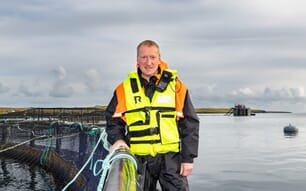Salmon Pancreas Disease Virus (SPDV), also referred to as Salmonid alphavirus (SAV), causes pancreas disease (PD) in Atlantic salmon and sleeping disease in rainbow trout.
While all strains of the virus are recognised to be closely related members of the same virus species, they can be assigned to six genogroups (SAV subtypes 1 ?6), based on minor differences in the sequences of their nucleic acid.
The geographical distribution of these subtypes in marine salmon production is now well characterized. In Ireland, SAV isolates of subtypes 1 and 4 are present (plus the only isolate of SAV subtype 6 made to date).
In Scotland, isolates of subtypes 1, 2, 4 and 5 are present, while in Norway SAV subtype 3 has been the predominant strain, although subtype 2 isolates have emerged recently. Within each of these countries there is also evidence of further geographic localisation of different subtypes.
While the minor differences between these subtypes at the genetic level is well recognised, the serological cross reactivity between the genetically distinguishable strains of SAV has not been systematically characterized until recently. In addition to providing further insights into the relationship between strains, these differences also have practical relevance in terms of the efficacy of vaccines and the selection of antibodies for diagnostic testing.
A recent study conducted by the Fish Diseases Unit (FDU) of the Agri-food and Biosciences Institute in Belfast and MSD Animal Health (Bergen) has investigated these relationships through cross-neutralisation studies using sera from both experimental and field studies.
In the first part of the work, serum samples from groups of fish which had each been challenged under experimental conditions with a single subtype of virus were used. The neutralising ability of these sera, as measured against the virus used to generate them (homologous virus-serum pairs) was then compared with the titres obtained when they were tested in turn against strains representing each of the 5 other subtypes (heterologous virus-serum pairs).
The second part of the study conducted a similar analysis, using serum samples from natural outbreaks of PD in farmed salmon. These had been shown to have been caused by SAV subtypes 1, 4 and 5, based on diagnostic investigations (including virus strain typing) carried out previously by the Fish Diseases Unit.
With the exception of the level of SAV subtype 6 neutralization by heterologous sera, good cross neutralisation was detected between strains representing all other subtypes using sera from experimental infections, albeit with some variation in the titres recorded. A similar pattern was evident with field sera, except that heterologous neutralisation of the SAV6 strain was more evident. These findings are consistent with those of earlier, more limited studies, with a high level of serological cross reactivity between isolates representing all subtypes typically being detected.
The vaccine NORVAX Compact PD contains a SPDV strain that genotypically clusters as a SAV1 strain. While other elements of the immune system have also been shown to be capable of contributing to a protective immune response the data suggest that an immune response generated against SAV subtype 1 can be expected to provide protection against challenge with the major other subtypes currently encountered in aquaculture. This is in line with another report showing that a SAV1-based vaccine protects at least as well as a vaccine based on a SAV3 isolate when fish are challenge with an SAV3 strain.
Compared to its use in other diagnostic arenas, VN testing is still not widely used in aquaculture, although it is becoming more widely accepted. From a diagnostic perspective, it is critical that the SAV subtype used as a test virus is susceptible to neutralization by antisera raised against all strains of the virus.
The results of the current study suggest that this is the case for all of the major subtypes, with testing therefore expected to demonstrate a high level of diagnostic sensitivity, particularly when applied at cage or site level.
October 2013




